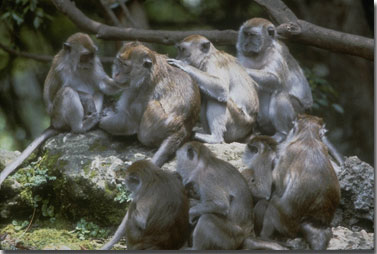Long-Tailed Macaque (Macaca fascicularis)
 Long-tailed Macaque or
Crab-eating Macaque (Macaca fascicularis) is
one of exotic fauna in Irian Jaya. The monkey arrived in Papua region
during the World War II when the monkey introduced by the U.S. Army to
develop the bio-indicator of eatable fruits in the Irian Jaya forest. The
program develop to ensure the troop's food supply in guerilla. After
the war, the monkey left in Vim forest in Jayapura city.
Long-tailed Macaque or
Crab-eating Macaque (Macaca fascicularis) is
one of exotic fauna in Irian Jaya. The monkey arrived in Papua region
during the World War II when the monkey introduced by the U.S. Army to
develop the bio-indicator of eatable fruits in the Irian Jaya forest. The
program develop to ensure the troop's food supply in guerilla. After
the war, the monkey left in Vim forest in Jayapura city.
The monkey distributed from Vim forest to Abepura beach. Recently, there are three large groups of monkey in the forest, the group of 25 monkey occupies the Meer hills, another group of 18 monkey occupies Fongabi, Tebery, Waymhok, and Embrok hills and the last group of 25 monkey occupies Mauno hills. Instead of the area, the monkey also occupies the mountainous area from the south of Sentani Lake to Arso valleys, particularly in 1980s. WWF South Pacific Program also informed that the monkey also occupied the Bewani area in Papua New Guinea.
|
Jumping activity occupies 7.97% of their daily activities. This activity conducted for feed as well as playing in young monkey. |
Walking activity occupies 4.25% of their daily activities. This activity conducted to move the group from one place to another. |
Feeding activity occupies 2.54% of their daily activities. Feeding habit varies from one tree to another in the top of the hill to beach plain. Monkey likes to feed the petal, fruit and leaves. |
|
Eating Activity occupies 2.14 % of their daily activities. Food source is tip of spades, banyan and ironwood leaves. Also they eat cowpeas, peanuts, sweet potato, cassavas, tip of pineapple leaves and coconut.. |
Resting Activity Resting occupies 2.83 % of their daily activities. The group usually take a rest after finishing some activities of jumping, walking, feeding and eating.
|
Social Activity for young monkey is playing, looking for fleas and suckling. For adult, they also doing sexual activity. The pattern occupies 1.78% of their daily activities.
|
Management of the monkey has been established in many approaches, including the provision of trade quota for 200 monkey annually by the Ministry of Forestry in 1999. Indirectly, suburban development in Abepura and Kutaraja also limits their habitat. It is concerned that such approach can develop the extensive distribution of the monkey, so it is appropriate to setup an integrated management plan to address the issue.